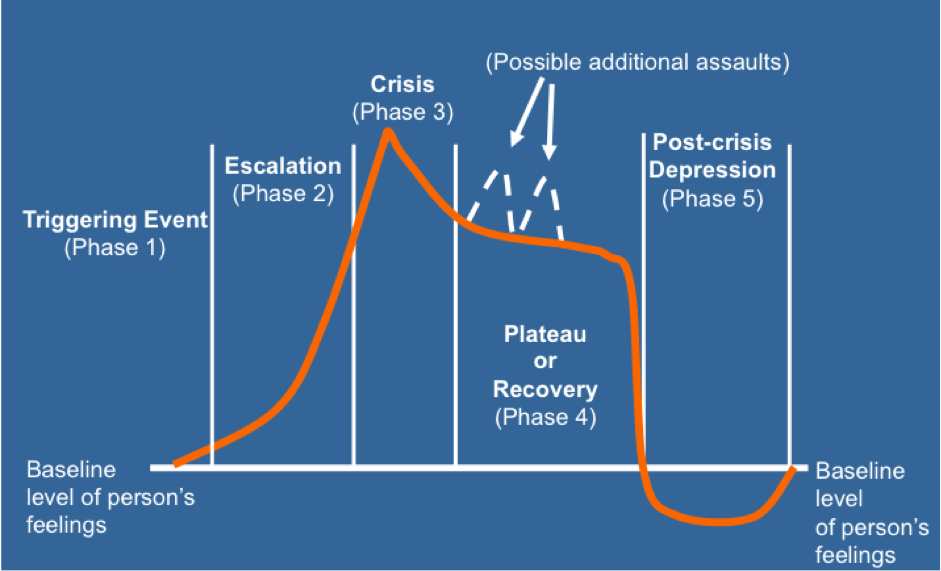Most situations involving aggressive behaviour and potential violence can be broken into a series of phases. Prevention of aggression and violence is best approached through analysing and assessing the phases of an incident and implementing appropriate risk-reduction measures to manage the situation effectively. If handled well, all incidents are an opportunity for learning and development for all concerned. The primary concern for practitioners during an incident is to restore circumstances to a pre-incident baseline in a way that results in the least possible degree of harm for everyone involved including staff, clients and the person/s being aggressive.
The series of phases that an incident involve all concerned but follow the experience of the aggressor. The 5 phases are:
Phase 1: Triggering event(s)
When anger is provoked through one or more triggering events (see aspect 5 of this module), it can escalate into aggressive behaviour and potentially violence. Triggering events vary between individuals (and in some cases groups) and can occur in the presence of practitioners or can relate to an incident outside the service.
Phase 2: Escalation
The escalation stage can occur very quickly or gradually develop over a period of time depending on the individual, the nature of the triggering event and the setting. During the escalation phase, in response to triggering events, the potentially aggressive young person is affected physiologically in preparation for 'flight or fight'. Adrenaline is released, the muscles tense, breathing becomes rapid and blood pressure rises.
Phase 3: Crisis
The crisis phase involves the young person behaving in an aggressive manner, either physically or verbally, towards another person, an object or themselves. This may include shouting, throwing or hitting an object and/or striking a person. Where clients are emotionally dysregulated and highly aroused their ability to process information and understand or care about consequences will be extremely limited. As is the case with the escalation stage, the crisis phase may be reached very quickly or gradually depending on the individual, the nature of the triggering event and the setting. Depending on what occurs for the aggressor during the crisis phase (including how it is handled by practitioners) further escalation can occur. The length of time that the crisis lasts will also vary accordingly.
Phase 4: Recovery
Once the crisis has peaked and is abating, the aggressor enters a plateau or recovery stage where anger begins to subside. It takes time for the body to return to normal. During this stage it is easy for anger and aggressive behaviour to be retriggered and to again escalate to crisis point. This is because the person is still partly aroused, and the feelings that accompany this phase are likely to leave the person feeling vulnerable and confused.
Phase 5: Post crisis depression
Following a post crisis period of recovery the person that has been aggressive and violent will often experience a period of ‘post-crisis depression’ before equilibrium is restored and their feelings return to baseline. During this phase, the person that has been aggressive and violent might feel tired, unhappy, guilty or ashamed about the incident and their behaviour. This can confirm negative core self-beliefs and create a sense of hopelessness. This can potentially lead to self-destructive behaviour and there is an increased suicide risk. Clients who use substances and/or self injury as a coping strategy will potentially turn to these behaviours.

Diagram 1. Phases of incidents involving aggressive & potentially violent behaviour
